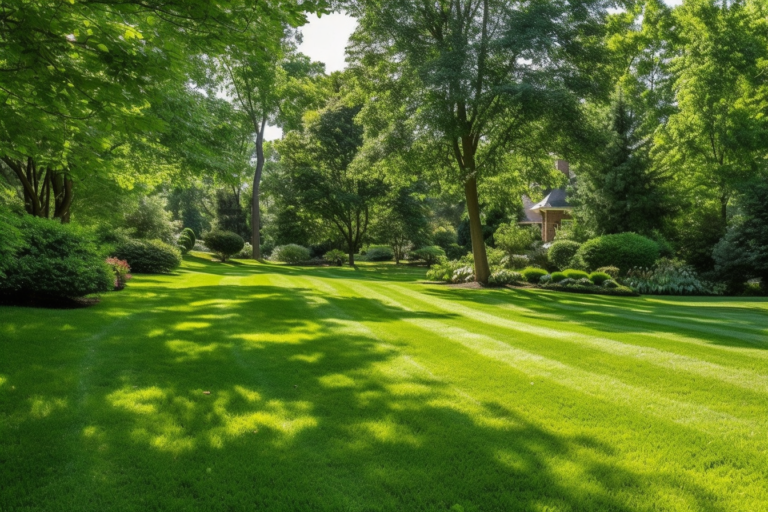Summer is here, and we all want our lawns to be lush and vibrant throughout the season. One crucial aspect of maintaining a healthy lawn is proper watering. In this article, we’ll discuss how often to water your lawn in summer, offering you valuable tips and insights to keep your grass green and thriving.
The Importance of Proper Watering
The Role of Water in Lawn Health
Water is essential for lawns, as it plays a vital role in various processes, such as:
- Nutrient absorption
- Photosynthesis
- Cooling the plant
- Aiding in cell growth
The Consequences of Overwatering and Underwatering
Overwatering and underwatering can both have detrimental effects on your lawn:
- Overwatering can lead to shallow root systems, making your lawn more susceptible to diseases, pests, and drought stress.
- Underwatering can cause grass to turn brown and dry, making it more prone to weed invasion and other issues.
Factors Influencing Watering Frequency
Several factors come into play when determining how often to water your lawn in summer:
Soil Type
Different soil types have varying water retention capacities:
- Sandy soils drain quickly and require more frequent watering.
- Clay soils retain water longer and need less frequent watering.
- Loamy soils are a balanced mix of sand, silt, and clay and have moderate water retention capacities.
Grass Type
Grass species have unique water requirements:
- Cool-season grasses (e.g., Kentucky bluegrass, fescue) require less water than warm-season grasses (e.g., Bermuda, St. Augustine).
- Drought-tolerant grasses (e.g., buffalo grass, zoysia) need less water than non-drought-tolerant species.
Weather Conditions
Weather greatly impacts lawn watering frequency:
- Hot, dry weather requires more frequent watering.
- Cooler temperatures or rainy weather reduce the need for watering.
Irrigation System
An efficient irrigation system helps maintain consistent moisture levels:
- Sprinkler systems can distribute water evenly.
- Drip irrigation systems deliver water directly to the root zone, reducing evaporation.
General Watering Guidelines
How Often to Water
As a general rule, water your lawn:
- 2-3 times per week for sandy soils
- 1-2 times per week for clay soils
- 2 times per week for loamy soils
When to Water
Water your lawn early in the morning (between 4-10 am) to reduce evaporation and improve water absorption.
How Much to Water
Apply 1-1.5 inches of water per week to encourage deep root growth.
Signs That Your Lawn Needs Water
Keep an eye out for these signs that your lawn needs water:
- Footprints remain visible on the grass.
- Grass blades turn blue-gray.
- Soil becomes hard and dry.
Tips for Efficient Watering
Follow these tips for efficient lawn watering:
- Use a rain gauge to measure water application.
- Water deeply and infrequently to encourage deep root growth.
- Adjust your watering schedule based on weather conditions.
Effective Techniques for Watering Your Lawn
Maintaining a healthy and lush green lawn requires proper watering techniques. Overwatering or underwatering a lawn can cause damage to the grass roots and result in a weak and patchy lawn. Here are some effective techniques for watering your lawn during summer:
Water your lawn early in the morning
Watering your lawn early in the morning before the sun is high and the temperature rises is an effective technique. The cooler temperatures and lower evaporation rates give the grass blades adequate time to absorb the water and dry before nightfall.

Water deeply but infrequently
Grass roots require deep watering to promote sturdy and deep root systems. Shallow watering can result in weak and shallow roots, making the lawn more susceptible to drought. Watering should be done infrequently, but make sure to water for longer periods so that the water penetrates deep into the soil.
Use a sprinkler with an adjustable spray pattern
A sprinkler system with adjustable spray patterns allows for uniform water distribution across the lawn. It also provides more control over the water output, allowing the homeowner to adjust the pattern according to the shape and size of the lawn.
Monitor the lawn for signs of drought
Keeping a close watch on the lawn is crucial for preventing drought stress. Signs of drought stress include the grass blades turning brown or yellow, and footprints remaining visible on the grass for an extended period. When these signs appear, it is essential to water the lawn immediately.
Consider the climate and grass type
Different grass types have different watering needs, and the climatic conditions play a significant role in determining the watering frequency. Warm-season grasses require less water than cool-season grasses, and this should be kept in mind when deciding on a watering schedule.
Following these effective watering techniques can help maintain an attractive and healthy lawn during the summer season. Remember to keep irrigation systems well-maintained and adjust watering techniques according to unpredictable weather conditions.
Tips for Conserving Water While Watering Your Lawn
As an expert on lawn care, I understand the importance of conserving water while keeping your lawn healthy and green during the hot summer months. Here are some tips for reducing water usage while still ensuring your lawn stays nourished:
- WATER EARLY IN THE MORNING: Watering your lawn in the early morning, when temperatures are cooler and sunlight is less intense, helps to minimize evaporation. This means that the water you apply will have a better chance of reaching the roots of your grass, where it’s needed, rather than evaporating into the air.
- USE A SPRINKLER TIMER: Using a sprinkler timer can help you avoid over-watering your lawn. Set it up to turn on and off at appropriate intervals, based on the weather and the needs of your lawn. This not only saves water but also ensures that your lawn does not become waterlogged, which can cause its own problems.
- ADJUST YOUR SPRINKLER SYSTEM: If you have an automatic sprinkler system, make sure to adjust it often throughout the summer. Factors to consider include the weather, the time of year, and the soil type. You should also check regularly for leaks or broken sprinkler heads, which can waste water and damage your lawn.
- MOW HIGH: Keeping your grass a little longer (around 3 inches) can help it retain moisture and reduce the need for frequent watering. This is because the longer blades of grass provide more shade for the soil, which helps prevent evaporation.
- USE DROUGHT-RESISTANT GRASS: If you’re starting a new lawn or planning to reseed, consider using drought-resistant grass varieties (such as Bermuda or Buffalo grass). These types of grasses require less water than other types, which can save you money on your water bill.
By following these simple tips, you can help to conserve water while still having a healthy and attractive lawn all summer long.
When to Consult a Professional
While watering your lawn may seem like a simple task, there are times when it’s best to consult a professional. Here are some situations where it might be beneficial to bring in an expert:
- Large Lawns: If you have a large lawn or a complex irrigation system, it can be difficult to determine the best watering schedule. In such cases, a professional can help you design an optimal irrigation system that’s efficient and eco-friendly.
- Experts Inspection: If you’ve been watering your lawn according to recommended guidelines, but it still looks unhealthy, it may be time to consult with an expert. They’ll be able to check for any underlying issues such as soil compaction, pests, and diseases that could be causing your lawn’s poor health.
- Drought-Prone Regions: If you live in a region that’s prone to droughts, it’s essential to water your lawn effectively to prevent water wastage. In such cases, a professional can offer you advice on soil moisture retention, plant selection, and other drought-resistant options that are suitable for your area.
- Busy Schedule: If you don’t have enough time to water your lawn correctly, a professional can do it for you. They have the necessary tools and equipment to ensure that your lawn gets the right amount of water and fertilizers, no matter how busy your schedule is.
- Inexperience: If you’re new to lawn care, it can be overwhelming to determine the correct water requirements for your grass type, soil type, and climate. A professional can help you understand the best practices and provide you with ongoing support to ensure that your lawn stays healthy all year round.
Remember, hiring a professional may add some additional cost to your budget, but it’s an investment worth making to ensure that your lawn remains lush, healthy, and vibrant.
Conclusion
Knowing how often to water your lawn in summer is crucial for maintaining a healthy, lush landscape. By considering factors like soil type, grass species, and weather conditions, you can develop an effective watering schedule. Remember to monitor your lawn for signs of water stress and adjust your watering practices accordingly.
FAQS
Is it better to water my lawn in the morning or evening?
Watering in the morning (between 4-10 am) is ideal, as it reduces evaporation and allows for better water absorption.
Can I water my lawn every day?
Watering your lawn every day is not recommended, as it can lead to shallow root systems and other problems. Instead, water deeply and infrequently, following the general guidelines outlined in this article.
How can I tell if I’m overwatering or underwatering my lawn?
Overwatered lawns may have shallow root systems, yellowing grass, and increased disease or pest issues. Underwatered lawns often have brown, dry grass and may be more prone to weed invasion. Monitor your lawn for these signs and adjust your watering practices accordingly.
Do I need to water my lawn if it rains?
If it rains enough to provide the recommended 1-1.5 inches of water per week, you do not need to water your lawn. Use a rain gauge to measure rainfall and adjust your watering schedule accordingly.
Should I water my lawn during a heatwave?
During a heatwave, your lawn may require more frequent watering to combat the increased evaporation and higher temperatures. Adjust your watering schedule to ensure your lawn receives adequate moisture.



I always struggle with how often to water my lawn in the summer. This article was really helpful and gave me a good idea of what to do. Thanks!